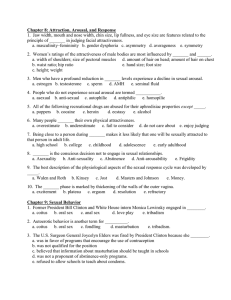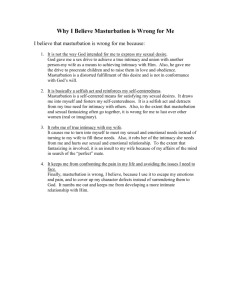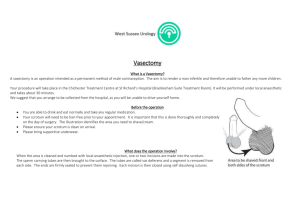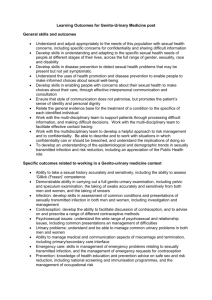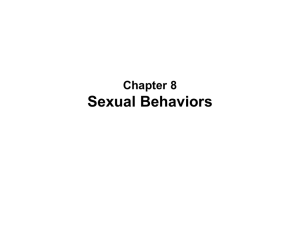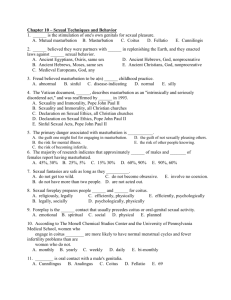Chapter 8: Attraction, Arousal, and Response
advertisement
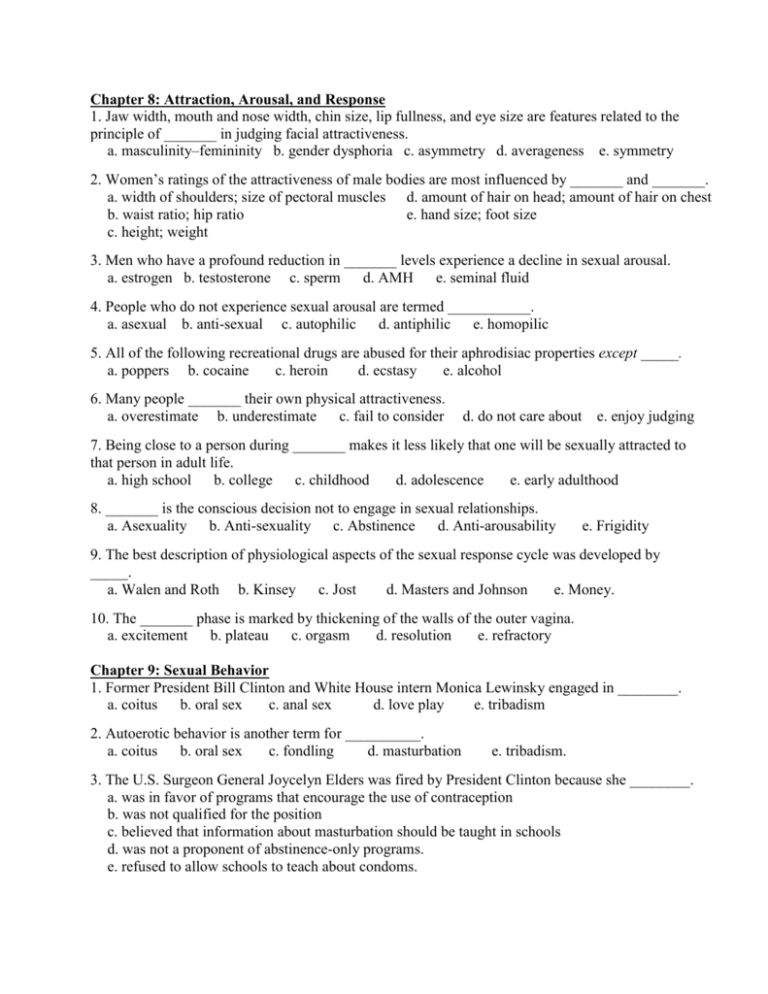
Chapter 8: Attraction, Arousal, and Response 1. Jaw width, mouth and nose width, chin size, lip fullness, and eye size are features related to the principle of _______ in judging facial attractiveness. a. masculinity–femininity b. gender dysphoria c. asymmetry d. averageness e. symmetry 2. Women’s ratings of the attractiveness of male bodies are most influenced by _______ and _______. a. width of shoulders; size of pectoral muscles d. amount of hair on head; amount of hair on chest b. waist ratio; hip ratio e. hand size; foot size c. height; weight 3. Men who have a profound reduction in _______ levels experience a decline in sexual arousal. a. estrogen b. testosterone c. sperm d. AMH e. seminal fluid 4. People who do not experience sexual arousal are termed ___________. a. asexual b. anti-sexual c. autophilic d. antiphilic e. homopilic 5. All of the following recreational drugs are abused for their aphrodisiac properties except _____. a. poppers b. cocaine c. heroin d. ecstasy e. alcohol 6. Many people _______ their own physical attractiveness. a. overestimate b. underestimate c. fail to consider d. do not care about e. enjoy judging 7. Being close to a person during _______ makes it less likely that one will be sexually attracted to that person in adult life. a. high school b. college c. childhood d. adolescence e. early adulthood 8. _______ is the conscious decision not to engage in sexual relationships. a. Asexuality b. Anti-sexuality c. Abstinence d. Anti-arousability e. Frigidity 9. The best description of physiological aspects of the sexual response cycle was developed by _____. a. Walen and Roth b. Kinsey c. Jost d. Masters and Johnson e. Money. 10. The _______ phase is marked by thickening of the walls of the outer vagina. a. excitement b. plateau c. orgasm d. resolution e. refractory Chapter 9: Sexual Behavior 1. Former President Bill Clinton and White House intern Monica Lewinsky engaged in ________. a. coitus b. oral sex c. anal sex d. love play e. tribadism 2. Autoerotic behavior is another term for __________. a. coitus b. oral sex c. fondling d. masturbation e. tribadism. 3. The U.S. Surgeon General Joycelyn Elders was fired by President Clinton because she ________. a. was in favor of programs that encourage the use of contraception b. was not qualified for the position c. believed that information about masturbation should be taught in schools d. was not a proponent of abstinence-only programs. e. refused to allow schools to teach about condoms. 4. _______ is oral stimulation of the vulva. a. Fellatio b. Anilingus c. Coitus d. Cunnilingus e. Tribadism 5. _______ experience orgasm more frequently during masturbation than when engaged in sex with a partner. a. Men b. Women c. Lesbians d. Children e. Asexual people 6. Which of the following statements might attest to the strong association between education level and frequency of masturbation? a. Highly educated people are less religious than other groups. b. Highly educated people believe that the main reason to have sex is to procreate. c. Highly educated people are older than other groups. d. Highly educated people are more sexually inhibited than other groups. e. Uneducated people believe that pleasure is the main reason for having sex. 7. Two people simultaneously performing oral sex on each other is referred to as ________. a. 81 b. 69 c. 33 d. 10 e. 99 8. The _______ encouraged Americans to try alternative positions for coitus. a. gay rights movement c. Christian majority e. Islamic revolution b. women’s movement d. Kinsey Report 9. During anal sex, the penis passes the anal orifice and enters the _______, or the lowermost portion of the intestinal tract. a. duodenum b. colon c. rectum d. stomach e. thoracic cavity 10. The anus is normally kept closed by the sustained contraction of two _______ muscles. a. sphincter b. anal c. rectal d. skeletal e. inactive 11. Woman–woman sex is characterized by greater general _______ contact than heterosexual sex. a. body b. genital c. breast d. mouth e. buttock 12. On average, men take _______ minutes from the beginning of masturbation to the point of orgasm. a. 1–2 b. 2–3 c. 4 d. 5 e. 10 Chapter 10: Sexual Relationships 1. For some people, _______ is the only moral justification for sex. a. security b. status c. conformity d. procreation e. acceptance 2. Since the twelfth century all Roman Catholic clergy have been required to be __________. a. free of sin b. celibate c. married d. circumcised e. ascetic 3. Which of the following major world religions began with a negative view of sexual behavior? a. Reform Judasim b. Islam c. Tantric Buddhism d. Christianity e. The Quaker religion 4. People who believe that sex has a major purpose in cementing relationships tend to approve of sex between committed, unmarried persons but disapprove of _______ or _______ sex. a. extramarital; casual c. casual; gay e. anal; casual b. extramarital; procreational d. oral; anal 5. By and large, men no longer expect their brides or girlfriends to be _________. a. sexually active b. virgins c. educated d. attractive e. pro-choice 6. Two hormones that appear to be important for experiencing love are _______ and _______. a. testosterone; DHT c. ocytocin; vasopressin e. estrogen; vasopressin b. estrogen; prolactin d. testosterone; oxytocin 7. _______ love is the kind of love in which intimacy is high but passion and commitment are low. a. Companionate b. Consummate c. Romantic d. Fatuous e. Liking 8. Many therapists identify _______ problems as the number one reason for dissatisfaction in marriage and other long-term relationships. a. communication b. conflict c. sexual d. anger e. jealousy 9. Jealousy based on persistent false beliefs about a partner is called _______ jealousy. a. delusional b. paranoid c. maladaptive d. emotional e. sexual 10. African Americans tend to be less approving of _______ than whites. a. premarital sex b. extramarital sex c. abortion d. recreational sex 11. Casual sex is most prevalent among __________. a. heterosexual men c. heterosexual women b. homosexual men d. homosexual women e. traditional sex e. bisexual people 12. _______ in one form or another cements many sexual relationships. a. Sex b. Foreplay c. Love d. Religion e. Morality Chapter 12: Contraception and Abortion 1. An early feminist important in advancing the birth control movement in the United States was ____. a. Eleanor Roosevelt b. Amelia Earhart c. Margaret Sanger d. Camille Paglia e. Margaret Mead 2. _______ and _______ are the most popular reversible contraceptive methods in use. a. The pill; female sterilization c. The pill; condoms e. Vasectomy; NuvaRing b. Female sterilization; condoms d. The pill; vasectomy 3. Which of the following methods of male contraception is the most effective and reversible? a. Withdrawal b. Condom c. Vasectomy d. IUD e. ParaGard 4. Following coitus, a diaphragm should be left in place for at least _______ hours but no more than _______ hours. a. 1; 4 b. 4; 12 c. 6; 24 d. 4; 8 e. 12; 24 5. Constant-dose combination pills contain ___________. a. both estrogen and progestin b. estrogen only c. progestin only d. no sex hormones e. RU-486 6. Due to elevated health risks, women over the age of _______ and who _______ are advised not to use combination pills. a. 18; smoke b. 21; smoke c. 35; drink d. 21; drink e. 35; smoke 7. Combination pill failure rate is more likely in women over _______ pounds. a. 100 b. 155 c. 200 d. 255 e. 300 8. Contraceptives such as _______ allow hormones to enter the body via intramuscular injections. a. Implanon b. Ortho Evra c. NuvaRing d. Depo-SubQ Provera e. Depo-Provera 9. Oral sex, mutual masturbation, and body exploration as a substitute for coitus is called _______. a. foreplay b. outercourse c. intercourse d. afterplay e. effleurage 10. Fertility awareness methods of birth control are also known as ________. a. rhythm methods b. organic methods c. total abstinence d. barrier methods e. hormonal methods 11. Which of the following is the most effective method of birth control under conditions of typical use? a. ParaGard IUD b. Vasectomy c. Tubal ligation d. Sponge e. Withdrawal 12. During the first trimester of pregnancy, most surgical abortions are performed by _______. a. introducing a saline solution into the uterus c. vacuum aspiration e. RU-486 b. administering prostaglandins d. dilation and evacuation 13. Emergency contraception prevents ______________. a. fertilization b. implantation c. capacitation d. ovulation e. menstruation 14. Which of the following variables does not correlate with an individual’s position on abortion (whether it be pro-choice or pro-life)? a. Sex b. Religion c. Political affiliation d. Age e. Education level 15. The withdrawal method of contraception has a _______% failure rate with typical use. a. 7 b. 17 c. 27 d. 37 e. 46 16. Some condoms come precoated with __________. a. aphrodisiacs b. nonoxynol-9 c. pheromones d. oils e. petroleum jelly Chapter 11: Fertility, Pregnancy, and Childbirth 1. Of the many steps that a couple can take to maximize their chances for conceiving, the most important is ______. a. timing coitus with ovulation c. ejaculating frequently e. not exercising b. douching d. engaging in the woman-on-top position 2. The major symptom that first suggests to a woman that she is pregnant is ________. a. loss of sensation of breasts c. a missed period e. quickening b. increased energy d. spotting 3. Direct application of sperm to a woman’s uterus is called ________. a. in vitro fertilization c. subzonal drilling b. artificial insemination d. intracytoplasmic sperm injection e. zonal drilling 4. The most common site for abnormalities of the female reproductive tract that result in subfertility is the _________. a. vagina b. ovaries c. oviducts d. uterus e. cervix 5. Children born of older mothers are more likely to be affected by _______ syndrome. a. Marfan b. Down c. fetal alcohol d. androgen insensitivity e. Klinefelter 6. Fetal loss due to blood group incompatibility occurs when a fetus possesses the blood group antigen ______. a. Rh factor b. hCG c. prolactin d. oxytocin e. vasopressin 7. The phenomenon of pregnancy-like symptoms in fathers is called _________. a. false pregnancy b. pseudopregnancy c. couvade d. hysterical pregnancy e. intimate love 8. The procedure in which a thin needle is inserted into the sac that holds a fetus to sample fluid containing fetal cells is called _________. a. IVF b. villus sampling c. ultrasonography d. ART e. amniocentesis 9. Labor consists of several stages, with delivery of the baby being stage _____. a. one b. two c. three d. four e. five 10. The thinning of the cervix during the first stage of labor is called _________. a. dilation b. effleurage c. effacement d. transition e. encouragement 11. _______, a drug commonly used to treat acne, can cause birth defects. a. Thalidomide b. DES c. Accutane d. LH e. FSH 12. The beginning of the fertile window is on day _______ prior to ovulation. a. 1 b. 2 c. 3 d. 4 e. 5 13. Down syndrome affects 1 in _______ births in mothers who are 30 years old. a. 25 b. 250 c. 550 d. 885 e. 1250 14. According to _______ rule, a pregnant woman’s due date is 9 months plus 1 week after the onset of her last menstrual period. a. Bradley’s b. Braxton’s c. Kinsey’s d. Lamaze’s e. Naegele’s 15. A technique called _______ can be used to separate X-bearing sperm from Y-bearing sperm. a. IVF b. ART c. amniocentesis d. sonography e. flow cytometry 16. Light stroking of the abdomen or thighs, known as _______, reduces perceived pain during childbirth. a. effuvescent b. effleurage c. Lamaze d. quickening e. engagement 17. In some species, the fetus secretes _______ to initiate parturition. a. estrogen b. corticosteroids c. gonadotropins d. DHT e. hCG
